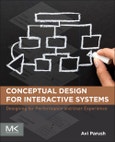Readers will gain a better understanding of the framework they need to perceive, understand, and experience their tasks and processes in the context of their products. The text is ideal for those seeking a proven, innovative strategy for meeting goals through intuitive and effective thinking.
Please Note: This is an On Demand product, delivery may take up to 11 working days after payment has been received.
Table of Contents
Preface What is this book about? Is this book for you? How is the book organized? Part 1: The conceptual model Fundamentals Chapter 1: A multiple and cross-channel example Setting an appointment Chapter 2: Places, routes, and abstraction Chapter 3: A layered framework for the conceptual model Chapter 4: The Function layer Chapter 5: The Configuration layer Chapter 6: The Navigation & Policy layer Chapter 7: The detailed layers Chapter 8: Summary of the components of the conceptual model according to the layered framework Chapter 9: Conceptual models matter! - Implications to human performance, usability, and experience Chapter 10: A typology of conceptual models Summary of Part 1 Part 2: Conceptual design A methodology Chapter 11: Conceptual design in context Think strategically Chapter 12: Conceptual design- An overview of the methodology Chapter 13: First, user research. Just do it Chapter 14: Functional Chunks: Construct the essential foundation Chapter 15: Configuration: Draw your first rough sketch of the conceptual model Chapter 16: Navigation Map: Moving from one place to another Chapter 17: Navigation Policy: Define the "Rules of the Road� Chapter 18: Form Transition to detailed design Chapter 19: Summary Conceptual Design Methodology in a glance Epilogue: Beyond the conceptual model and onto detailed design








